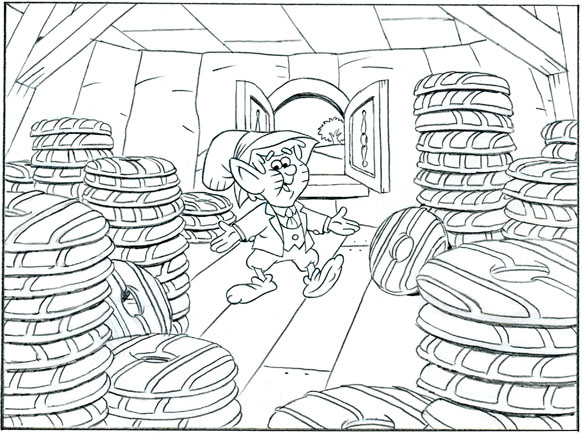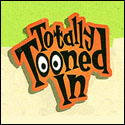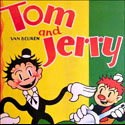
So this week we take a look at the origins of the famous Keebler Elves. I had this industrial film (embed below) from 1970 in my collection for years – it wasn’t already on You Tube, so I put my fading print out for all to share. It’s a supposed recreation of how the first Keebler Elf commercial was conceived and produced at the Leo Burnett Agency. Two things: 1. It’s not the first Keebler Elf spot and 2. I believe all the ad men in the film are professional actors (any help to identifying who’s who is appreciated – is that “Hi Guy” Bill Fiore as one of the singers?).
One familiar face (and voice) is Alan Reed (Fred Flintstone) as the voice of the main Elf. You’ll also hear Joe Flynn as the voice of the window washer.
Not sure why there is a clip from The Funny Company in this – but the commercial animation is credited to Film Fair. Mike Kazaleh says “it’s a good bet that Sam Cornell did the designs (perhaps based on art by cartoonist Roger Bradfield?) and Alan Zaslove did the animation.”
Despite the above, this Keebler Elf commercial (below) seems to precede the above by at least a year or so. This spot, for Keebler Wheat Toasts and Rye Toasts crackers, features an elf here named “Ollie” voiced by Daws Butler. The animation was produced at Hanna-Barbera – Mike Kazaleh says its by Jerry Hathcock and Irv Spence.
Kazaleh did this drawing of Ernie Keebler for an agency pitch board – it’s too good not to include in this post. Print it out and color it in with crayons. Thanks Mike for this, and all your help with this post.



 Jerry Beck is a writer, animation producer, college professor and author of more than 15 books on animation history. He is a former studio exec with Nickelodeon Movies and Disney, and has written for The Hollywood Reporter and Variety. He has curated cartoons for DVD and Blu-ray compilations and has lent his expertise to dozens of bonus documentaries and audio commentaries on such. Beck is currently on the faculty of CalArts in Valencia, UCLA in Westwood and Woodbury University in Burbank – teaching animation history. More about Jerry Beck [
Jerry Beck is a writer, animation producer, college professor and author of more than 15 books on animation history. He is a former studio exec with Nickelodeon Movies and Disney, and has written for The Hollywood Reporter and Variety. He has curated cartoons for DVD and Blu-ray compilations and has lent his expertise to dozens of bonus documentaries and audio commentaries on such. Beck is currently on the faculty of CalArts in Valencia, UCLA in Westwood and Woodbury University in Burbank – teaching animation history. More about Jerry Beck [








I realize that this is off-topic I but couldn’t find any relevant posts to include it. YouTube has a collection of uncut episodes of Rowan & Martin’s Laugh-In and one episode had a couple of clips of Jim Backus. It also had a faux-animation of Mr. Magoo in his Uncle Sam outfit doing gags and plugging his upcoming special. Is anyone familiar with the technique they used for his “animated” scenes? I seem to remember it showing up somewhere else back then and it using rods to move the character. Here’s the episode
https://www.youtube.com/watch?v=5kXYop-tSKs
and the Magoo clips appear at :20, 11:13, 11:38, 19:50 and 31:37.
Art, I remember those segments, and the best I heard about this technique- i forget where-Is that is that the “Magoo” figure was not animation per se, but a flat puppet figure drawn on foam or some semi flexible cardboard, and the puppeteers blocked out by the chromakey/bluescreen process. Therer was a similar character called Lorleli the Chicken during the early seasons of THE ELECTRIC COMPANY What was worked in a similar way. I’m sorry iIcouldn’t give you something more ‘Official”.
Thank you, Chris. I’m guessing that there was a flap over the eye to manipulate them also. I think there were experiments in computer animation going on about the time of this show (1969) but they were still strictly in the lab and not ready for prime time yet.
The “live animation” technique used for Lorelei the Chicken was called Aniform.
Its creator (the puppeteer who was responsible for Foodini) was VERY strict on keeping the technology a secret, thus protecting his methods from intellectual theft. He insisted that only his own trained staff of puppeteers could manipulate the Aniforms, and that the Aniforms were carried in, in sealed cases, and the Aniforms themselves were taken out and installed by the approved puppeteers in complete solitude. When it was time to pack up, it was also done only by those approved puppeteers, again in complete solitude.
Jim Boyd was one of those approved puppeteers, who was cast on “The Electric Company” purely to operate and voice the “Lorelei the Chicken” Aniform, as well as several traditional puppets, Paul the Gorilla, and the voice of the then-unseen J. Arthur Crank (who made “Crank calls” complaining about a particular segment that had just aired). In season 2, it was decided to bring “Crank” onscreen, which led to Jim playing many other onscreen characters.
I recognize one of the singers as Ron Masak from “Murder, She Wrote”. I know I’ve seen the Keebler representative and the man at the piano in 70’s soap operas but I can’t recall their names.
I don’t see Bill Fiore in there, but the singer on the left is Ron Masak.
Illustrator/cartoonist Roger Bradfield indeed designed the first Keebler elf characters.
https://www.newyorker.com/news/afterword/a-life-in-funny-pictures
Roger wrote a small boklet on animation that includes many of the first sketches of the elves. Roger passed away in Santa Barbara, California on December 31, 2021. My wife, (his daughter) and her siblings, have many memories, and still have various pieces of his earliest art.
Darn, I don’t have any crayons. I’ll have to settle for watercolor instead…..
Great post Jerry. I would love to read more history on these advertising icons (maybe a history on how Tony the Tiger was conceived?).
So I loved seeing this, and thank you for posting it. I’m going to suggest that they weren’t really trying to pass off the spot depicted as the first ever Keebler Elves commercial. It’s clearly an educational film intended for young-ish children, so they’re trying to explain in simple terms how they come up with an idea for selling a product, in this case cookie-baking elves, and then made the film using whichever spot in the series happened to be in production at the time.
And I should add that I didn’t realize there was this earlier “head elf” character played by Alan Reed. The countless Keebler spots I saw as a kid all had the later chief elf voiced by Parley Baer.
The man on the far left at the 9:26 mark is Jed Allan, indeed a veteran of several soap operas (“Days Of Our Lives” and “Santa Barbara”). He also starred on “Lassie” in the late ’60s.
Both Parley Baer and Walker Edmiston supposedly did Ernie’s voice for years. Parley once told me, “Thank GOD for Keebler!” and said they’d kept him going when other work was sparse. After Parley’s stroke, they seemed to stop using voices in the commercials at all. So…when did Walker Edmiston do Ernie’s voice? Anybody know?
I suspect the “Funny Company” clip added at the intro is to remind corporate executives how advertising can be geared to children. Executives are not the brightest of people to begin with, and they need to be reminded why and how and for what they are spending their money on.
You sure Don Draper started this way? But seriously, folks…
That use of hatching lines to contour faces was such a part of late 60’s-early 70’s animation…not so much Hanna-Barbera or Filmation as the smaller studios making commercials and series. (Though that style did creep in at De Patie-Freleng and Jay Ward’s.) I’m talking Roger Ramjet, some of the Sesame Street-Electric Company sequences, the John Wilson Sonny and Cher cartoons, and of course lots of commercials.
It would be tough to imagine using that technique now with computer-aided animation; take Dr. Seuss’s Cat in the Hat; when he moves, say an arm, it looks like cutout animation because the computer holds the hatching pattern steady. You need human “imperfection” to make it work…
Jerry, I created that look of the of the Keebler elf. I was working at Filmfair at the time. I picked Roger Bradfield to design the spots. I also did additional character design. I also directed and cast the voices. It was a fresh look at the time. Loose water-color vignettes.
I did the first campaign and then moved on. Of course I cast Parley Baer as the main elf. He once told me he was a lion tamer in a small circus. He also told me how much he enjoyed the gig. Most of the animation was done by Dale Case.
See? That’s why we do posts like this! Thank you Bob – because of you I’ve been a chocolate chip cookie monster my whole life!
My father helped create those elves and I have the style sheets to prove it… His name was Pete Eaton of Eaton & Iwen
What’s odd is I don’t recall any of the Keebler commercial from the 1960’s and 1970’s. What I remembered is back in the 1970’s I saw a 5 second portion of a Keebler commercial until it was interrupted for another commercial ! Mind you that Keebler cookies and crackers were not sold in Southern California until 1984. So every time a Keebler commercial was shown here it was literally cut off the air and was replaced by another commercial! Talk about depriving a childhood by having your local TV affiliate station by not allowing a child to see the Keebler elves commercials because the product wasn’t sold in your local neighborhood grocer or supermarket chain!
Vonnie Batson and Marie Harvey Cornell is among the ink and paint artists
The information is WRONG My father Pete Eaton of Eaton & Iwen was the first to draw the eves and I have the style sheets to prove it..
https://www.facebook.com/photo.php?fbid=2025509202684&set=a.1557190735015&type=3&theater